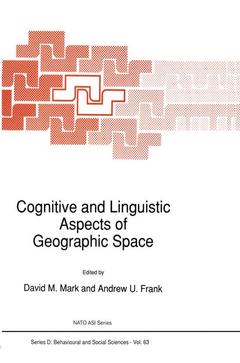Cognitive and Linguistic Aspects of Geographic Space, 1991 NATO Science Series D: Series, Vol. 63
Langue : Anglais
Coordonnateurs : Mark D.M., Frank Andrew U.

This book contains twenty-eight papers by participants in the NATO Advanced Study Institute (ASI) on "Cognitive and Linguistic Aspects of Geographic Space," held in Las Navas del Maxques, Spain, July 8-20, 1990. The NATO ASI marked a stage in a two-year research project at the U. S. National Center for Geographic Infonnation and Analysis (NCOIA). In 1987, the U. S. National Science Foundation issued a solicitation for proposals to establish the NCGIA-and one element of that solicitation was a call for research on a "fundamental theory of spatial relations". We felt that such a fundamental theory could be searched for in mathematics (geometry, topology) or in cognitive science, but that a simultaneous search in these two seemingly disparate research areas might produce novel results. Thus, as part of the NCGIA proposal from a consortium consisting of the University of California at Santa Barbara, the State University of New York at Buffalo, and the University of Maine, we proposed that the second major Research Initiative (two year, multidisciplinary research project) of the NCOIA would address these issues, and would be called "Languages of Spatial Relations" The grant to establish the NCOIA was awarded to our consortium late in 1988.
Cognitive and Linguistic Aspects of Geographic Space: An Introduction.- Section 1: Geographic Space.- 1.1 Geographic Space as a Set of Concrete Geographical Entities.- 1.2 Some Notes on Geographic Information Systems: The Relationship Between their Practical Application and their Theoretical Evolution.- 1.3 A Hand-In-Glove Paradigm for Geography.- Section 2: Cultural Influences on the Conceptualization of Geographic Space.- 2.1 “Through the Door”: A View of Space from an Anthropological Perspective.- 2.2 Culture as Input and Output of the Cognitive-Linguistic Processes.- 2.3 Dialogic and Argumentative Structures of Bumper Stickers.- Section 3: Wayfinding and Spatial Cognition.- 3.1 The Development of the Abilities Required to Understand Spatial Representations.- 3.2 Making Sense of Human Wayfinding: Review of Cognitive and Linguistic Knowledge for Personal Navigation with a New Research Directioa.- 3.3 Wayfinding Theory and Research: The Need for a New Approach.- 3.4 The Effect of the Pattern of the Environment on Spatial Knowledge Acquisition.- 3.5 Methods for Measuring Spatial Cognition.- 3.6 Path Finding in Free Space Using Sinusoidal Transforms: III.- Section 4: Cartographic Perspectives.- 4.1 Mapping as Language or Semiotic System: Review and Comment.- 4.2 Plan Information and its Retrieval in Map Interpretation: The View from Semiotics.- 4.3 An Approach to Map/Text Interrelationships.- 4.4 Spatial Knowledge for Image Understanding.- Section 5: Formal Treatment of Space in Mathematics.- 5.1 The Mathematical Modeling of Spatial and Non-Spatial Information in Geographic Information Systems.- 5.2 Map Algebra as a Spatial Language.- 5.3 Qualitative Spatial Reasoning.- 5.4 Relative Representation of Spatial Knowledge: The 2-D Case.- 5.5 Matching Representations ofGeographic Locations.- 5.6 The Role of Modal Logics in the Description of a Geographical Information System.- Section 6: User Interfaces and Human-Computer Interaction.- 6.1 A Formalization of Metaphors and Image-Schemas in User Interfaces.- 6.2 Elicitation of Spatial Language to Support Cross-Cultural Geographic Information Systems.- 6.3 UGIX: A Layer Based Model For A GIS User Interface.- 6.4 Deficiencies of SQL as a GIS Query Language.- 6.5 The Role of the User in Generalization within Geographic Information Systems.- 6.6 Virtual Worlds, Inside and Out.- Appendix: NATO Advanced Study Institute Participants.
Date de parution : 10-2012
Ouvrage de 519 p.
15.5x23.5 cm
Thèmes de Cognitive and Linguistic Aspects of Geographic Space :
Mots-clés :
Action; cognitive science; evolution; geographical information system; geography
© 2024 LAVOISIER S.A.S.
